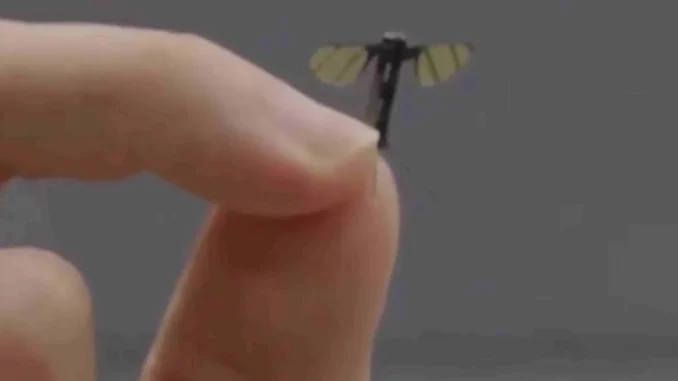
| Published June 25, 2025
Watch out for mosquitoes!
In a startling leap forward for surveillance technology, China has unveiled a mosquito-sized microdrone engineered for covert military and intelligence operations. Developed by researchers at the National University of Defense Technology (NUDT), the insect-like device is designed to mimic the size and movements of a real mosquito—making it nearly undetectable to the naked eye or radar. Touted as a breakthrough in micro-robotics, the drone is capable of discreet audio, video, and electronic signal collection, raising serious questions about global espionage, battlefield ethics, and privacy in the age of invisible surveillance.
🐝 What’s been unveiled?
-
The National University of Defense Technology (NUDT) in Hunan has introduced a mosquito-sized microdrone (~1.3 cm long, <0.3 g) with flapping leaf-like wings and ultra-thin legs, showcased on CCTV 7.
-
A student researcher described it as “especially suited to information reconnaissance and special missions on the battlefield”.
-
Equipped with ultra-miniature cameras and microphones, this device is designed for stealthy image, audio, and electronic signal collection—and invisible to radar.
🔍 Capabilities & Design
-
Appearance & features: ~1.3 cm “stick” body, dual insect-like flapping wings, and three fine legs for landing or perching.
-
Control: Remote-operated, even via a smartphone interface.
🚨 Challenges & Limitations
-
Battery life & range: Extremely limited due to micro size—flight duration likely very short.
-
Requires frequent redeployment and data collection cycles, limiting broader military applications.
⚖️ Security & Ethical Concerns
-
Espionage risks: Could infiltrate indoor spaces to monitor private conversations, collect sensitive corporate or personal data.
-
Potential misuse: Experts warn of possible deployment by criminals, using drones for data theft or even delivering harmful biological agents.
-
Escalating stealth warfare: Signals a broader push toward increasingly covert and biologically inspired systems .
🌍 How it compares globally
-
Similar efforts exist, such as Norway’s Black Hornet micro-UAV, though most are palm-sized—not insect-sized.
-
The Chinese move reflects a growing global trend capitalizing on robot miniaturization for both military and civilian purposes.
Mosquito recon drone for the PLA.
Our military can leverage China’s advanced consumer electronics sector, to rapidly prototype and test new ideas efficiently.
When a solution to a problem is found, then rapid mass production.
This is the core essence of military-civil fusion.… pic.twitter.com/ZBC5GkeAmh
— Zhao DaShuai 东北进修🇨🇳 (@zhao_dashuai) June 21, 2025
 Advantages and Disadvantages
Advantages and Disadvantages
Advantages
-
Stealth Surveillance: The drone’s insect-like size and movement make it nearly invisible to the naked eye and radar systems, allowing for undetected reconnaissance.
-
Precision Intelligence Gathering: Equipped with mini cameras and microphones, it can collect audio-visual data in hard-to-reach or high-risk areas.
-
Urban Warfare Utility: Ideal for dense environments where conventional drones would be too large or noisy.
-
Symbol of Technological Advancement: Demonstrates China’s rapid progress in micro-robotics and military innovation.
Disadvantages
-
Limited Battery Life: Due to its tiny size, flight time is extremely short, reducing operational duration.
-
Restricted Payload Capacity: It cannot carry additional tools or sensors, limiting its multifunctionality.
-
Vulnerability to Environmental Factors: High winds, rain, or heat could easily compromise its function.
-
Espionage & Privacy Risks: Raises serious ethical concerns about domestic spying, data theft, and civilian surveillance misuse.
 Bottom Line:
Bottom Line:
China’s unveiling of a mosquito-sized microdrone marks a significant step forward in the militarization of micro-robotics. While its stealth and precision capabilities present clear tactical advantages, the technology also introduces a host of ethical, logistical, and security concerns. Its current limitations—such as power constraints and environmental vulnerability—highlight that it’s more of a prototype than a battlefield-ready tool. Still, the implications are clear: warfare and surveillance are entering an era where the line between biology and technology continues to blur. As global powers race to develop similar innovations, the debate over how such tools should be regulated is only just beginning.
SOURCES: THE NEW YORK POST – China unveils eerie mosquito-sized drone designed for stealth military operations — nearly invisible to naked eye
THE GATEWAY PUNDIT – SCARY: China Unveils New Mosquito Drone for Covert Military Operations
SOUTH CHINA MORNING POST – Chinese military robotics lab creates mosquito-sized microdrone for covert operations
FUTURISM – Chinese Military Shows Off Fly-Sized Drones for Covert Ops





Be the first to comment